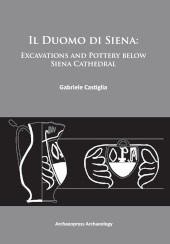2014 - Archaeopress Publishing
E-book
Digital Version
Download | Copia/pega | Impresión
Il Duomo di Siena : Excavations and Pottery below the Siena Cathedral
160 p.
- This book is the result of the processing of the excavation data and of the pottery coming from the stratigraphy underneath the cathedral of Siena. The surveys were conducted between August 2000 and May 2003 by the Department of Archaeology and History of Arts of the University of Siena, with the scientific coordination of Prof. Riccardo Francovich and Prof. Marco Valenti and the collaboration of the Opera del Duomo di Siena. The ultimate goal is to trace a view of the settlement types and economic framework that has affected the hill of the Cathedral from the Classical age to the late Middle Ages, combining stratigraphic data and the study of materials. The limited planimetric extension of the excavations (often physiological to urban contexts) did not allow an investigation in open area, so the findings have often been compared with those coming from the deposits investigated in the immediate vicinity, both in front and below the Santa Maria della Scala, in order to obtain a more complete and articulated pe
- rspective on a diachronic context. The stratigraphy is developed over a time span ranging from the 7th century BC until the 20th century AD, unearthing a very structured sequence that represents a significant view in understanding the evolutionary dynamics of the urban fabric of Siena: in this regard, it is important to emphasize the fact that the chronological junction on which most attention is focused on is between the Augustian Age and the end of the 14th century, since the survey revealed that the archaeological deposit is better preserved in the time period between the two phases mentioned above and, as a result, the restitution of ceramics has been more complete. The settlement/economic dynamics developed over this extended period in different ways and this is what we are going to analyse: the goal is to develop a dialogue between stratigraphic deposit and material culture, with the aim of understanding the evolution of an urban reality, especially in those phases that led to the crisis of the "classic
- al" city and its consequent transformation and reconfiguration between Late Antiquity and the Early Middle Ages. [Publisher's text].
- Illustrated throughout in black and white.
-
Información


